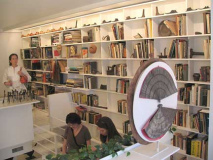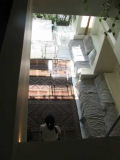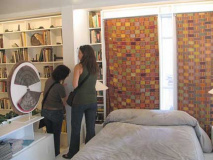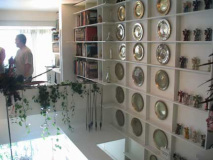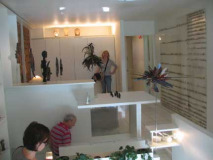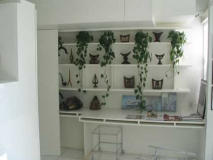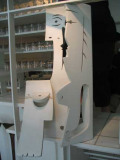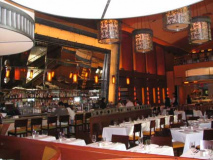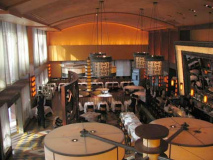FNY’s second installment of Open House NY 2007 takes your webmaster to a narrow, 3-story house on East 58th Street designed and built by Modernist architect Paul Rudolph, and a swank restaurant in the Rock Center vicinity dominated by my favorite color, orange…
The Modulightor Building, 246 East 58th Street near 2nd Avenue and the Queensboro Bridge entrance, was one of the final works of Paul Rudolph (1918-1997). Modulightor, a company creating lighting systems for business and retail, has its offices and showroom in the building as well as the Paul Rudolph Foundation.
Paul M. Rudolph was born a minister’s son in Elkton, Kentucky. Inspired by architecture at an early age, Rudolph studied architecture as an undergraduate at Alabama Polytechnic (now Auburn University), and after a brief period in the Navy during WWII, successfully completed Graduate studies at Harvard under Bauhaus founder Walter Gropius. Rudolph was early on a pioneering architect in Sarasota, Florida, a major figure of the ‘Sarasota School of Architecture’. He was Dean of the Yale School of Architecture from 1958-1965, and after his tenure continued through the next 30 years to create unique and powerful architecture. Despite the wane of Rudolph’s reputation during the dominance of Post-Modernism in the late 70’s and 80’s, his work and legacy has had a profound impact on the architecture of our era. Rudolph is considered one of America’s greatest Late Modernist architects and was an inspirational mentor to those he taught. His former students include some of contemporary architecture’s most internationally respected architects including Lord Norman Foster, Lord Richard Rogers, and Robert A.M. Stern, among many others distinguished in the field. Rudolph Foundation
Every section of the all-white interior is designed for maximum efficiency and lightness. In the cantilevered, interlocking planes, one can see the influence of Frank Lloyd Wright and Le Corbusier, but Rudolph’s individuality is visible in the miraculous airiness of the compact spaces. Counterbalancing his austere minimalism are Rudolph’s collections of mundane and exotic objects; tiny Roman terracotta heads populate the dining room table and decorated Transformer figurines stare down from the bookcases, approving of the versatile spaces below. L Magazine
This remarkable multi-story space, which Rudolph built for himself and his partner, is unlike any apartment you will ever experience. The largely white interior is made of a complex series of intricately interwoven horizontal and vertical spaces. Rudolph created a delicate sequence of floating steps cantilevered and suspended, dissolving almost invisibly into the fabric of the shelves of the apartment. The floating levels almost become transparent creating a space that is light and airy. Steps floating, moving, and changing direction are all part of the design, which constantly changes as one moves through the spaces. The apartment is filled with the artistic collections of both Paul Rudolph and his partner Ernst Wagner, the current owner of Modulightor Lighting whose offices are on the ground level of the building. Justin Ferate
Rudolph’s former penthouse at 23 Beekman Place (also flagged for landmark status) featured a transparent bathtub that could be observed from the living room.
Steve Garza visited the Modulator Building during OHNY 2006.
 Bar Americain, 152 West 52nd Street near 6th Avenue, was remodeled from the former Judson Bar in 2005 by architect David Rockwell and is “Iron Chef” Bobby Flay‘s NYC outlet; the fare is largely classic American, but not the pretentiousness its French name might impart, reviewers say.
Bar Americain, 152 West 52nd Street near 6th Avenue, was remodeled from the former Judson Bar in 2005 by architect David Rockwell and is “Iron Chef” Bobby Flay‘s NYC outlet; the fare is largely classic American, but not the pretentiousness its French name might impart, reviewers say.
David Rockwell has done something remarkable. By painting the interior a rusty Vasquez Rocks orange, shifting the bar to the center back wall, and incorporating a duo of low-standing lighting trees, he’s made the room appear smaller, even warm at first glance. Only when settled in do you acknowledge Bar’s size, but without intimidation. (Tables for two, however, are wide enough to hold a foosball set.) New York Magazine
10/10/07


